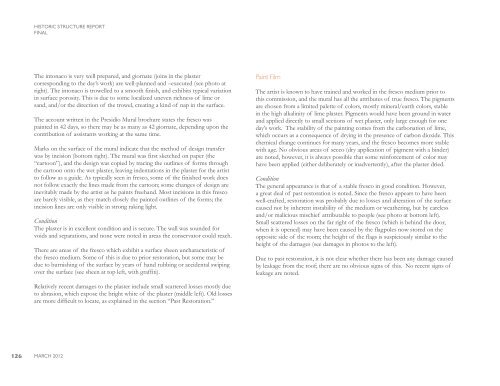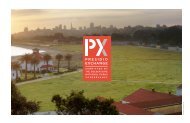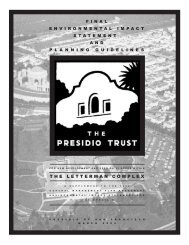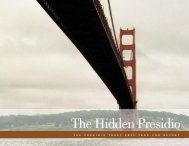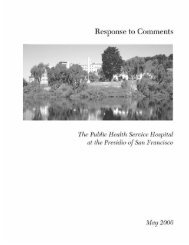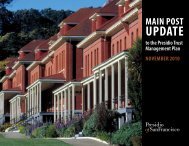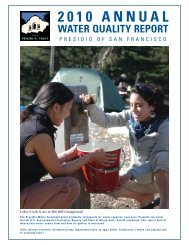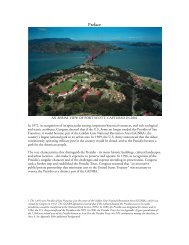Presidio Chapel Historic Structure Report - Presidio Trust
Presidio Chapel Historic Structure Report - Presidio Trust
Presidio Chapel Historic Structure Report - Presidio Trust
- No tags were found...
You also want an ePaper? Increase the reach of your titles
YUMPU automatically turns print PDFs into web optimized ePapers that Google loves.
HISTORIC STRUCTURE REPORTFINALThe intonaco is very well prepared, and giornate (joins in the plastercorresponding to the day’s work) are well-planned and –executed (see photo atright). The intonaco is trowelled to a smooth finish, and exhibits typical variationin surface porosity. This is due to some localized uneven richness of lime orsand, and/or the direction of the trowel, creating a kind of nap in the surface.The account written in the <strong>Presidio</strong> Mural brochure states the fresco waspainted in 42 days, so there may be as many as 42 giornate, depending upon thecontribution of assistants working at the same time.Marks on the surface of the mural indicate that the method of design transferwas by incision (bottom right). The mural was first sketched on paper (the“cartoon”), and the design was copied by tracing the outlines of forms throughthe cartoon onto the wet plaster, leaving indentations in the plaster for the artistto follow as a guide. As typically seen in fresco, some of the finished work doesnot follow exactly the lines made from the cartoon; some changes of design areinevitably made by the artist as he paints freehand. Most incisions in this frescoare barely visible, as they match closely the painted outlines of the forms; theincision lines are only visible in strong raking light.ConditionThe plaster is in excellent condition and is secure. The wall was sounded forvoids and separations, and none were noted in areas the conservator could reach.There are areas of the fresco which exhibit a surface sheen uncharacteristic ofthe fresco medium. Some of this is due to prior restoration, but some may bedue to burnishing of the surface by years of hand rubbing or accidental swipingover the surface (see sheen at top left, with graffiti).Paint FilmThe artist is known to have trained and worked in the fresco medium prior tothis commission, and the mural has all the attributes of true fresco. The pigmentsare chosen from a limited palette of colors, mostly mineral/earth colors, stablein the high alkalinity of lime plaster. Pigments would have been ground in waterand applied directly to small sections of wet plaster, only large enough for oneday’s work. The stability of the painting comes from the carbonation of lime,which occurs as a consequence of drying in the presence of carbon dioxide. Thischemical change continues for many years, and the fresco becomes more stablewith age. No obvious areas of secco (dry application of pigment with a binder)are noted, however, it is always possible that some reinforcement of color mayhave been applied (either deliberately or inadvertently), after the plaster dried.ConditionThe general appearance is that of a stable fresco in good condition. However,a great deal of past restoration is noted. Since the fresco appears to have beenwell-crafted, restoration was probably due to losses and alteration of the surfacecaused not by inherent instability of the medium or weathering, but by carelessand/or malicious mischief attributable to people (see photo at bottom left).Small scattered losses on the far right of the fresco (which is behind the door,when it is opened) may have been caused by the flagpoles now stored on theopposite side of the room; the height of the flags is suspiciously similar to theheight of the damages (see damages in photos to the left).Due to past restoration, it is not clear whether there has been any damage causedby leakage from the roof; there are no obvious signs of this. No recent signs ofleakage are noted.Relatively recent damages to the plaster include small scattered losses mostly dueto abrasion, which expose the bright white of the plaster (middle left). Old lossesare more difficult to locate, as explained in the section “Past Restoration.”126MARCH 2012


